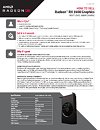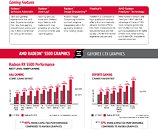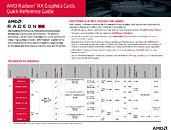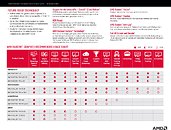Friday, November 8th 2019

AMD Radeon RX 5500 Marketing Sheets Reveal a bit More About the Card
Marketing material of AMD's upcoming Radeon RX 5500 mid-range graphics cards leaked to the web, providing insights to the product's positioning in AMD's stack. The October 2019 dated document lists out the card's specification, performance relative to a competing NVIDIA product, and a provides a general guidance on what experience to expect form it. To begin with, the RX 5500 desktop graphics card is based on the 7 nm "Navi 14" silicon, and is configured with 22 RDNA compute units, amounting to 1,408 stream processors. The chip features a 128-bit wide GDDR6 memory bus, which is paired with either 4 GB or 8 GB of memory running at 14 Gbps data-rate, yielding 224 GB/s of memory bandwidth. Its GPU clocks are listed as 1670 MHz "gaming," and 1845 MHz boost. The company didn't mention nominal clocks. The typical board power is rated at 110 W, and a single 8-pin PCIe power input is deployed on the reference-design board.
The second slide is where things get very interesting. AMD tabled its product stack, and the RX 570, RX 580, and RX 590 are missing, even as the RX 560 isn't. This is probably a sign of AMD phasing out the Polaris-based 1080p cards in the very near future, and replacing them with the RX 5500, and possibly a better endowed "RX 5500 XT," if rumors of the "Navi 14" featuring more CUs are to be believed. What is surprising about this whole presentation though is that only the "RX 5500" is listed, with the "XT" nowhere in sight. Let's hope the XT version gets released further down the road. In the product stack, the RX 5500 is interestingly still being compared to the GeForce GTX 1650, with no mention of the GTX 1660. This document was probably made when the GTX 1660 Super hadn't launched. A different slide provides some guidance on what kind of experiences to expect from the various cards, rated N/A, good, better, or excellent. According to it, the RX 5500 should provide "excellent" AAA gaming at 1080p, fairly smooth gaming at high settings (graded "better"), "excellent" e-Sports gaming, and "better" 1440p gaming. The card is also "excellent" at all non-gaming graphics, such as watching 4K video, photo/video creator work, game streaming at any resolution, and general desktop use.
Source:
juggies (Reddit)
The second slide is where things get very interesting. AMD tabled its product stack, and the RX 570, RX 580, and RX 590 are missing, even as the RX 560 isn't. This is probably a sign of AMD phasing out the Polaris-based 1080p cards in the very near future, and replacing them with the RX 5500, and possibly a better endowed "RX 5500 XT," if rumors of the "Navi 14" featuring more CUs are to be believed. What is surprising about this whole presentation though is that only the "RX 5500" is listed, with the "XT" nowhere in sight. Let's hope the XT version gets released further down the road. In the product stack, the RX 5500 is interestingly still being compared to the GeForce GTX 1650, with no mention of the GTX 1660. This document was probably made when the GTX 1660 Super hadn't launched. A different slide provides some guidance on what kind of experiences to expect from the various cards, rated N/A, good, better, or excellent. According to it, the RX 5500 should provide "excellent" AAA gaming at 1080p, fairly smooth gaming at high settings (graded "better"), "excellent" e-Sports gaming, and "better" 1440p gaming. The card is also "excellent" at all non-gaming graphics, such as watching 4K video, photo/video creator work, game streaming at any resolution, and general desktop use.




66 Comments on AMD Radeon RX 5500 Marketing Sheets Reveal a bit More About the Card
Just the fact that this is called 5500 should tell you that it's a midrange card significantly below the 5700. That AMD are comparing it to the GTX 1650 is another rather clear indicator.
Some of you have very short memories because the 2070FE launched at $600, with partner cards typically sitting at $520-550 depending on how serious the build quality and cooler design were.
Along comes AMD with a 2070-killer at $400 at a $120-200 discount and there's a whole load of whining about it being overpriced. Without AMD's competition, there would never have been a SUPER relaunch with the deep discounts Nvidia had to make.
There's no pleasing some people.... :rolleyes:
But it's sucess it will depend on the price tag, if it comes at 150/160$, I would say it would be a fair price considering the price that we can actually get the RX 570/580 now ,but I'm pretty sure they will price it higher. :/
The downside is literally those 4gb of vram, it might be enough for most games, but next gen consoles will surely drive games to use much more memory and higher resolution textures, 4gb might go from acceptable to bad in 1 or 2 years.
I think something in between this RX 5500 and the RX 5700 priced in between the 200 and 300 woud be also a very desired product.
Where are your sys specs?
If you look at AMD's endnotes of the RX 5500 benchmarks, you will see they choose best system to their hardware. In Nvidia's side, Nvidia's system is worse than AMD's. For this issue, customers don't know the truth.
Not that easy to read, but the bottom text is rather unequivocal.
Please back reality.
Notebookcheck.com
I'm not fanboy. I think this Navi 1 is useless because of the fact that Navi 2 is coming and it realases Q2 2020 with Ray Tracing. Navi 1 does not make sense to me due to the fact that it is only 1 year lifespan. For example, you have got RX 5700 XT and you are happy for now but in future games (Cyberpunk, GTA 6, Elder Scrolls 6) your hardware does not allow Ray Tracing and it is 400$. Maybe i can not play high settings with Ray Tracing but i will experience the RT.
I prefer wait to Ampere. You could see back to Pascal VS Maxwell. In same of terms, we will see it Ampere vs Turing.
2) The numbers you're quoting from NotebookCheck are grossly misleading without context. The RX 5500M "average" is based off a single pre-production laptop with a relatively slow 35W R7 3700H CPU, while the GTX 1650 average is based off a wide variety of more mature designs, most of them with faster and higher power (45W) Intel i7 CPUs. Where they're getting the "average" for the 5300M from is worth questioning, as they only posted some preliminary 3DMark results for that a few days back, where it soundly beats both an i5-9300H+1650 and i7-10710U+1650MQ. Of course 3DMark is hardly representative of gaming performance, but it's all we've got for now.
3) Why are you referring to Videocardz' repackaging of AMD's PR benchmark numbers rather than their own slides?
1. I use GPUs for 2-3 years because of the sell price. I bought RTX 2060 in January 2019,
2. Site uses average framerate, GTX 1650 used with R5 3550H, R7 3750H, i5 9300H, i7 9750H. RX5500M's drivers are very bad, AMD knew drivers are bad but they show their GPU's are good.
If we look specifications,
GTX 1650 Laptop has 1024 cores, GTX 1650 has 896 cores but GTX 1650 Laptop is 3.2 Tflops, GTX 1650 is 3Tflops. RX 5500M is %13 slower than RX 5500. RX 5500 is %26 faster than GTX 1650 in TPU benchmarks.
If we calculate these, RX 5500M is %5 faster than GTX 1650 Laptop NOT %30.(Average %5)
3. Videocardz uses AMD's benchmarks.
Comparing tflops across desktop and mobile Nvidia cards is problematic as the TFlops spec is normally calculated either at base clock or boost clock, but boost clock is power and thermal dependent and thus varies wildly due to GPU Boost 3.0. A desktop card will boost higher and for longer than a laptop card, even with identical on-paper specs, not to mention that power and thermal budgets for Nvidia's current mobile GPUs are OEM-dependent and can vary by quite stunningly high amounts (there are quite a few RTX 2060 laptops out there that are no faster than the same chassis with a GTX 1660 in it - and it's all down to power and cooling).
And yes, I know Videocardz was using AMD's benchmarks, I was just pointing out that it's rather odd of you to not use the original source material but rather a third-party representation of the data.
But still - shouldn't we be waiting for actual reviews of actually released products rather than arguing over speculation and theoretical numbers?
I'm only concerned about the 5300M anyway, in the desperate hope that AMD can bring some competition to the thin/light sub-15.6" laptop market. Currently there's the MX250 at 15-25W and the overpriced 1650 Max-Q at 35W and up. AMD have nothing to offer there at the moment.
For the rest of this year, and probably until stocks dry up, the RX570 is still king of the hill. It's a $120/£99/€99 before tax which is insanely good value and that's before special offers and game bundles are taken into consideration.